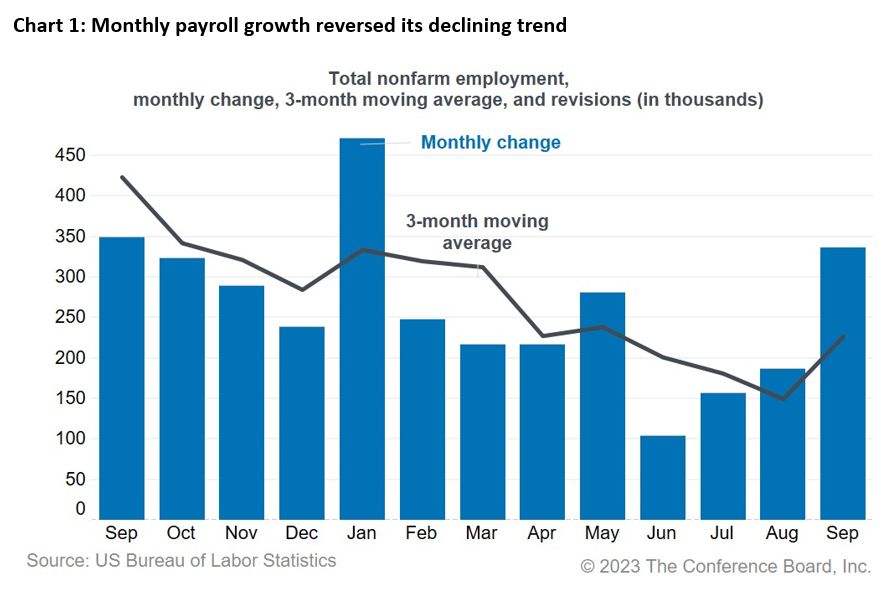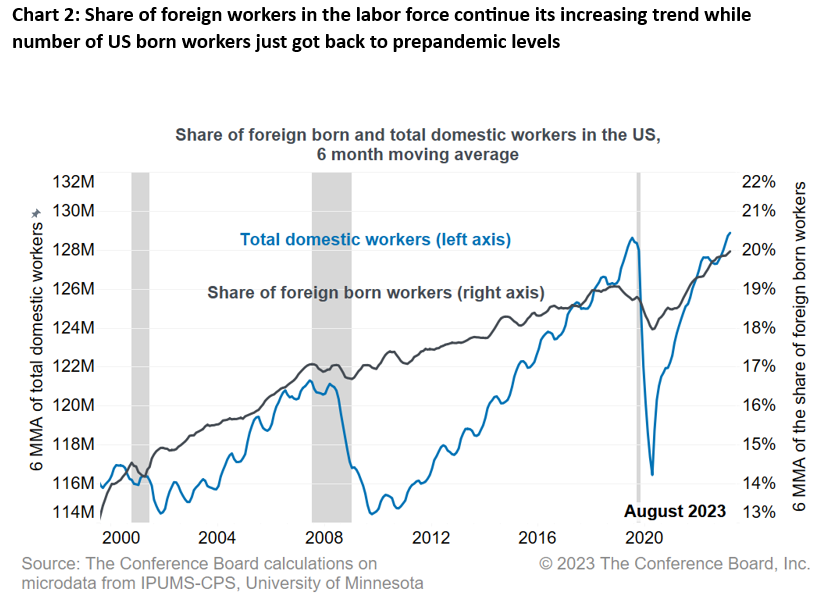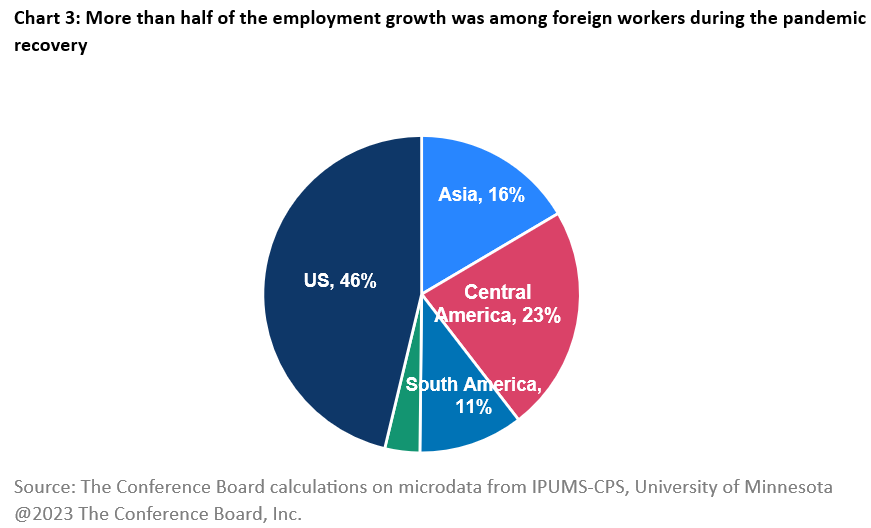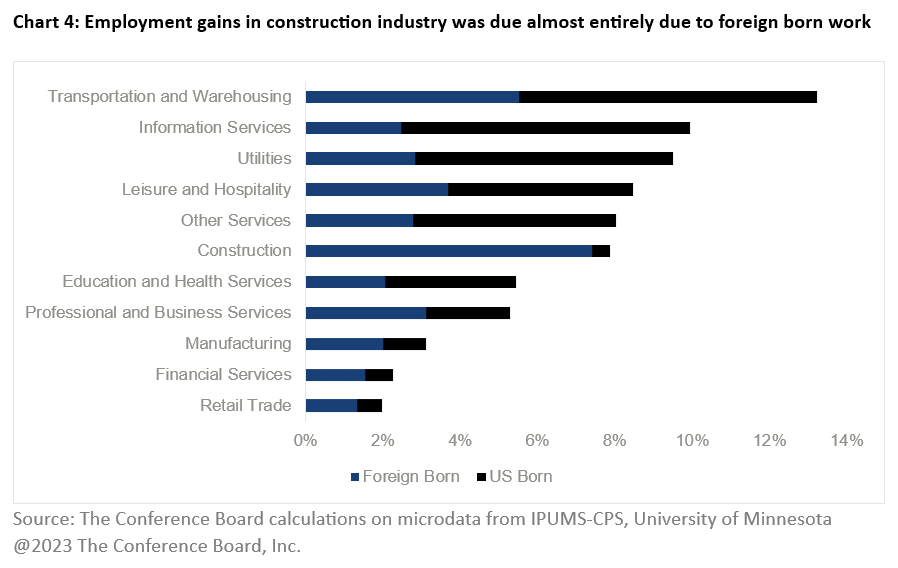Payrolls Rise in September by 336,000 Defying Expectations
06 Oct. 2023 | Comments (0)
Commentary on today’s US Bureau of Labor Statistics Employment Situation Report
Today’s jobs report showed that the US labor market was hotter than expected in September, adding 336,000 jobs. Furthermore, July and August payrolls were revised up by a combined 119,000 reversing the previously observed softening. Earlier data from JOLTS (Job Openings and Labor Turnover Survey) showed that job openings were up as well (driven by the rise in Professional and Business Services) suggesting the labor market is stronger than previously thought.
Wages also remain elevated as average hourly earnings increased by 4.2 percent year-over-year in September, compared to 4.3 percent in August. Wage growth is now significantly below last year’s peak of 5.9 percent, but well above prepandemic levels, and the rate of decline has been slow. Our Salary Increase Budget Survey shows that employers expect that elevated wage growth will continue with the average salary increase budget projected to rise by 4.1 percent in 2024. With wage growth staying elevated and consumer spending showing no signs of weakness, we project that the Federal Reserve will increase rates one more time in November and keep interest rates high longer eventually triggering a short but shallow recession.
Unemployment rate remained unchanged in September
The Household Survey revealed that the unemployment rate remained unchanged in September at 3.8 percent. The unemployment rate has hovered around in the 3.4-3.8 percent range since February 2022 with no sign of a material uptick as initial unemployment claims have remained low throughout this time. Similarly, the labor force participation rate didn’t change from August levels and stayed at 62.8 percent.
In-person services and government led job gains
Continuing the recent trend, payroll gains were driven by in-person service industries with health care (+40,900), social assistance (+25,000), and leisure and hospitality (+96,000) gaining jobs. The government added another 73,000 jobs, primarily in state and local government. Together these industries recorded 70 percent of job gains in September. Leisure and hospitality and the government sector are still trying to recover from pandemic job losses and are below February 2020 employment levels despite the resurgence. Health care and social assistance industries will continue adding jobs even during a downturn due to population aging. Other notable industries that recorded job gains in September were professional and business services (+21,000), retail trade (+19,700), manufacturing (+17,000) and construction (+11,000).
Cooling continues in select industries
The information services sector continued its negative employment trend and recorded jobs losses of −5,000. The industry has been losing jobs since layoffs started in the tech industry in November. Temporary help services—a leading indicator for hiring—continued to shed jobs, losing another −4,200 in September.

Immigration has been the backbone of labor market recovery after the pandemic and is key to continued growth with changing demographics.
Prior to pandemic (2010-19), total non-farm payroll employment grew by nearly 17 percent when the US averaged one million net immigrants a year, which contributed to more than half of the population increase during the decade. Pandemic restrictions brought immigration to a halt and impacted employment growth negatively. Once immigration rates returned to one million a year, the employment recovery quickly followed. Meanwhile, payrolls for US born workers are only back at its prepandemic level (Chart 2).

As immigration has been a polarizing issue, it becomes easy to forget how vital foreign born workers are to employment and hence economic growth. In the absence of immigration flows, labor shortages over the last decade would have been worse than they currently are. One way to see this is to look at the contribution of foreign-born workers to the pandemic recovery (Chart 3). Foreign born workers were responsible for more than half of the employment growth since April 2020 with 23 percent of added workers from Central America, 16 percent from Asia, and 11 percent from South America, and 4 percent from countries in other regions.

The impact of foreign-born workers on overall employment gains are even more visible at the industry level. Many industries benefited from immigration. The share of immigrants contributing to employment was significant for many sectors, for example in transportation and warehousing (41 percent) and information services (25 percent). Almost the entire recovery in the construction sector can be attributed to foreign-born workers, with three quarters of those workers born in Central America. Retail trade (67 percent), financial services (68 percent), professional and business services (59 percent), and manufacturing (64 percent) all had most of its gains from foreign born workers, with Asian workers having higher concentrations in these gains compared to workers from other regions.

US job growth continues to stay positive. Job openings remain elevated especially for in-person service industries. Organizations overwhelmingly report that they are having difficulties finding qualified workers and retaining existing ones. While we expect a short and shallow recession, we expect that labor shortages are expected to persist as the population continues to age. In fact, the BLS projects employment growth in the next decade will slow to nearly half of the previous decade’s level due to slow growth in the working age population. While increasing labor force participation and productivity are important solutions to labor shortages, an aging population and declining fertility present significant challenges to the size of the available labor pool and immigration will continue to be a very important tool to address these shortages.
-
About the Author:Selcuk Eren
The following is a bio of a former employee/consultant Selcuk Eren, PhD, is a Senior Economist at The Conference Board. He is an experienced researcher in labor economics with a focus on demographics…




0 Comment Comment Policy